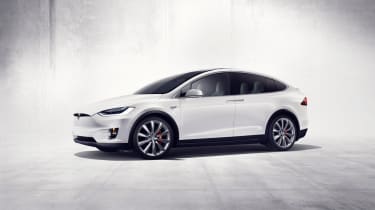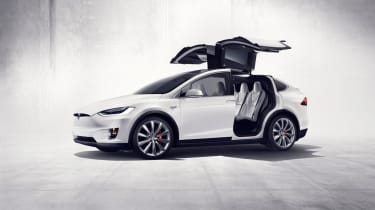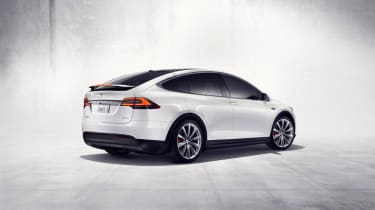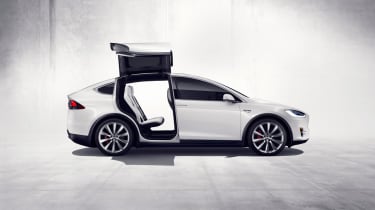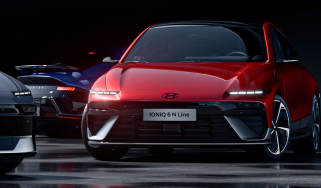Tesla Model X gets £64k 60D entry-level variant
SUV sprints to 60mph in as little as 3.2 seconds in P90D form, but boasts up to 303 miles of range
If you're keen on the new Tesla Model X but can't stomach the existing £71,900 entry price of the 75D model, the newly-announced Model X 60D might be more appropriate.
It maintains the same levels of performance as the 75D and still sends drive to all four wheels (the 'D' stands for Dual motor), but starts from £64,100, saving £7800.
The tradeoff is range: Where the 75D manages 259 miles on the European drive cycle, the 60D cuts that to 220 miles. That's still greater than every other electric car on the market in the UK and should give most buyers a suitable range for commuting purposes, but such a figure may soon become a minimum for new electric vehicles.
Performance won't be an issue though. The range-topping P90D minimises the penalty of its 2468kg kerb weight with two high-performance electric motors, enabling it to mix McLaren F1-aping performance with hybrid-beating running costs.
Tesla says it takes just 3.2 seconds for the Model X P90D to hit 60mph when in Ludicrous mode – matching the McLaren F1 and securing the Model X the title of the world’s quickest to 60 production SUV. This scintillating performance is provided by the same dual-electric motor powertrain as the Model S P85D, comprised of a 255bhp motor up front and a larger 496bhp motor at the rear.
This equates to a combined power output of 751bhp and 713lb ft of torque, ensuring that on paper at least, the Model X trumps the likes of proper hairy-chested supercars like Lamborghini’s Aventador SV. Of course, the 217mph dinosaur fuelled supercar is considerably faster, but a 155mph top speed for the Tesla isn’t exactly slow.
When not in Ludicrous mode, the Model X P90D will still reach 60mph in 3.8 seconds, and it’s only half a second slower at covering a quarter mile, taking 12.2 seconds. But in this mode, the car can eke out as much as 290 miles from a single charge, measured on the European cycle.
The regular Model X 90D manages the 0-60mph sprint in 4.8sec, while both the 60D and 75D take six seconds flat for the same sprint. Top speed is 155mph for both 90kWh models, and 130mph for the 60kWh and 75kWh cars.
This is particularly impressive when we consider that the car weighs 2.4 tons – about the same weight as a V8-engined Range Rover. One reason for the car’s impressive economy figures is its slippery exterior. Tesla is claiming that it has a drag-coefficient of just 0.24, which makes it the most aerodynamic production SUV in the world. A Porsche Cayenne, for example, has a drag coefficient of 0.36.
The Model X owes much of its sleekness to the fitment of an active spoiler, which can help improve efficiency by as much as 1.6 per cent.
Like in the Model S, Tesla has placed the Model X’s batteries (up to 90kWh of capacity) low in its floor, helping to ensure most of that hefty weight is kept as close to the ground as possible. This helps to maximise agility.
A standout feature for the new car are its 'falcon wing' rear doors. They open and close automatically, and allow for easy access to the car’s second row of seats - and its third row, in seven-seat models. Sensors prevent the doors smashing into nearby objects such as surrounding cars and garage ceilings.
Other tech features include a 360-degree camera to boost visibility, as well as 360 degree sonar sensors to trigger auto-pilot systems like Autopark and Autosteer. Radar also allows the Model X’s emergency auto brake function to work at (claimed) higher speeds than conventional systems.
On top of this, Tesla has also internally crash tested its new car and expects it to receive a five-star safety rating in the US, which would be a first for SUVs.
Range pricing starts at £64,100 for the Model X 60D and £71,900 for the 75D. The 90D begins at £82,400, while the range-topping P90D Performance will give you £200 change from a round £100k.
All those prices include VAT but don't include Tesla's delivery charge. Nor do they include any applicable incentives available to buyers, such as the UK government's plug-in car grant, so pre-options you'll likely pay less than the advertised price for each of the cars above. UK deliveries begin in early 2017.

